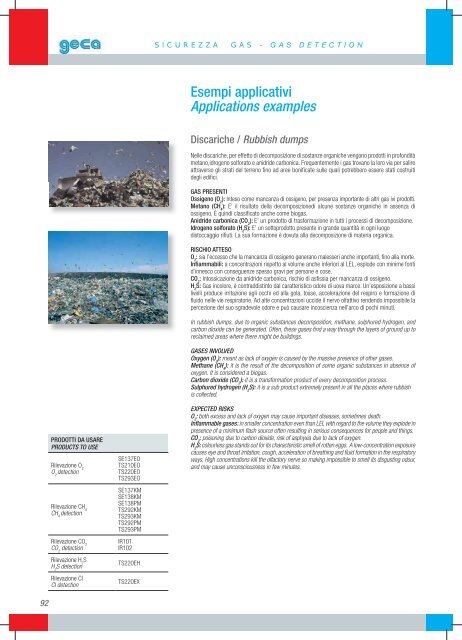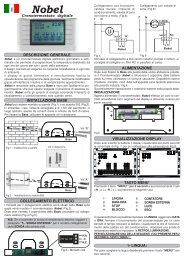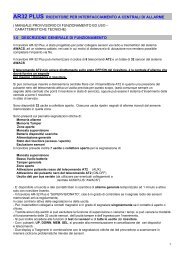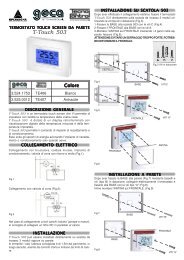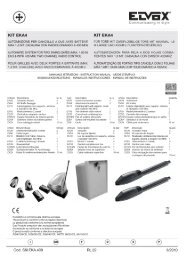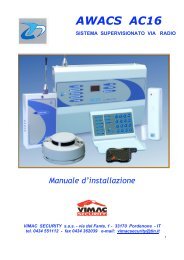Applications examples - Mgelettroforniture
Applications examples - Mgelettroforniture
Applications examples - Mgelettroforniture
Create successful ePaper yourself
Turn your PDF publications into a flip-book with our unique Google optimized e-Paper software.
SICUREZZA<br />
GAS - GAS DETECTION<br />
Esempi applicativi<br />
<strong>Applications</strong> <strong>examples</strong><br />
92<br />
PRODOTTI DA USARE<br />
PRODUCTS TO USE<br />
Rilevazione O 2<br />
O 2<br />
detection<br />
Rilevazione CH 4<br />
CH 4<br />
detection<br />
Rilevazione CO 2<br />
CO 2<br />
detection<br />
Rilevazione H 2<br />
S<br />
H 2<br />
S detection<br />
Rilevazione CI<br />
CI detection<br />
SE137EO<br />
TS210EO<br />
TS220EO<br />
TS293EO<br />
SE137KM<br />
SE138KM<br />
SE138PM<br />
TS292KM<br />
TS293KM<br />
TS292PM<br />
TS293PM<br />
IR101<br />
IR102<br />
TS220EH<br />
TS220EX<br />
Discariche / Rubbish dumps<br />
Nelle discariche, per effetto di decomposizione di sostanze organiche vengono prodotti in profondità<br />
metano,idrogeno solforato e anidride carbonica. Frequentemente i gas trovano la loro via per salire<br />
attraverso gli strati del terreno fino ad aree bonificate sulle quali potrebbero essere stati costruiti<br />
degli edifici.<br />
GAS PRESENTI<br />
Ossigeno (O 2<br />
): Inteso come mancanza di ossigeno, per presenza importante di altri gas ivi prodotti.<br />
Metano (CH 4<br />
): E’ il risultato della decomposizionedi alcune sostanze organiche in assenza di<br />
ossigeno. È quindi classificato anche come biogas.<br />
Anidride carbonica (CO 2<br />
): E’ un prodotto di trasformazione in tutti i processi di decomposizione.<br />
Idrogeno solforato (H 2<br />
S): E’ un sottoprodotto presente in grande quantità in ogni luogo<br />
distoccaggio rifiuti. La sua formazione è dovuta alla decomposizione di materia organica.<br />
RISCHIO ATTESO<br />
O 2<br />
: sia l’eccesso che la mancanza di ossigeno generano malesseri anche importanti, fino alla morte.<br />
Infiammabili: a concentrazioni rispetto al volume anche inferiori al LEL, esplode con minime fonti<br />
d’innesco con conseguenze spesso gravi per persone e cose.<br />
CO 2<br />
: Intossicazione da anidride carbonica, rischio di asfissia per mancanza di ossigeno.<br />
H 2<br />
S: Gas incolore, è contraddistinto dal caratteristico odore di uova marce. Un’esposizione a bassi<br />
livelli produce irritazione agli occhi ed alla gola, tosse, accelerazione del respiro e formazione di<br />
fluido nelle vie respiratorie. Ad alte concentrazioni uccide il nervo olfattivo rendendo impossibile la<br />
percezione del suo sgradevole odore e può causare incoscienza nell’arco di pochi minuti.<br />
In rubbish dumps, due to organic substances decomposition, methane, sulphured hydrogen, and<br />
carbon dioxide can be generated. Often, these gases find a way through the layers of ground up to<br />
reclaimed areas where there might be buildings.<br />
GASES INVOLVED<br />
Oxygen (O 2<br />
): meant as lack of oxygen is caused by the massive presence of other gases.<br />
Methane (CH 4<br />
): it is the result of the decomposition of some organic substances in absence of<br />
oxygen. It is considered a biogas.<br />
Carbon dioxide (CO 2<br />
): it is a transformation product of every decomposition process.<br />
Sulphured hydrogen (H 2<br />
S): it is a sub product extremely present in all the places where rubbish<br />
is collected.<br />
EXPECTED RISKS<br />
O 2<br />
: both excess and lack of oxygen may cause important diseases, sometimes death.<br />
Inflammable gases: in smaller concentration even than LEL with regard to the volume they explode in<br />
presence of a minimum flash source often resulting in serious consequences for people and things.<br />
CO 2<br />
: poisoning due to carbon dioxide, risk of asphyxia due to lack of oxygen.<br />
H 2<br />
S: colourless gas stands out for its characteristic smell of rotten eggs. A low-concentration exposure<br />
causes eye and throat irritation, cough, acceleration of breathing and fluid formation in the respiratory<br />
ways. High concentrations kill the olfactory nerve so making impossible to smell its disgusting odour,<br />
and may cause unconsciousness in few minutes.


